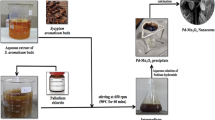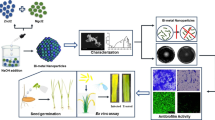Abstract
In order to achieve the food demand of a growing population, agricultural productivity needs to be increased by employing safe strategies. In the present study we have evaluated ZnONPs that were synthesized from the culture supernatant of Bacillus subtilis. Bio mimetically synthesized ZnONPs showed a surface resonance peak of 355 nm corresponding to NPs formation. Further, NPs were examined for their size, shape and element confirmation by DLS, AFM, SEM, TEM and EDAX, which confirmed the synthesized NPs were nearly spherical in size with average diameter of 32 nm by TEM. Surface charge of + 34.3 mV was observed for NPs with a low poly-dispersity index of 0.21. In vitro efficacy studies against fungi Colletotrichum capsici, Sclerotium rolfsii, Alternaria solani and Fusarium oxysporum f. sp. cicero showed up to 99% mycelial growth inhibition at 0.125% ZnONPs. Further, in-vitro disk-diffusion assay showed inhibition zones of 23 ± 0.4 mm and 12.67 ± 0.24 mm for Xanthomonas axonopodis pv. punicae (Xap) and Xanthomonas oryzae pv. oryzae (Xoo) bacterial cultures. Plant toxicity study was observed that ≤ 0.14% NPs concentration was safe under greenhouse conditions. Overall, the present study emphasizes the potential effect of ZnONPs against agricultural pathogens which play an important role in agriculture production.







Similar content being viewed by others
References
Ahmad H, Venugopal K, Rajagopal K, De Britto S, Nandini B, Pushpalatha HG, Konappa N, Udayashankar AC, Geetha N, Jogaiah S (2020) Green synthesis and characterization of zinc oxide nanoparticles using Eucalyptus globules and their fungicidal ability against pathogenic fungi of apple orchards. Biomolecules 10(3):425
Akpomie KG, Ghosh S, Gryzenhout M et al (2021) One-pot synthesis of zinc oxide nanoparticles via chemical precipitation for bromophenol blue adsorption and the antifungal activity against filamentous fungi. Sci Rep 11:8305
Bauer AW, Kirby WMM, Sherris JC, Turch M (1966) Antibiotic susceptibility testing by a standardized single disk method. Am J Clin Pathol 45:493–496
Chauhan R, Reddy A, Abraham J (2015) Biosynthesis of silver and zinc oxide nanoparticles using Pichia fermentans JA2 and their antimicrobial property. Appl Nanosci 5:63–71
Dhiman S, Singh S, Varma A et al (2021) Phytofabricated zinc oxide nanoparticles as a nanofungicide for management of Alternaria blight of Brassica. Biometals 34:1275–1293
Faizan M, Faraz A, Yusuf M, Khan ST, Hayat S (2018) Zinc oxide nanoparticle-mediated changes in photosynthetic efficiency and antioxidant system of tomato plants. Photosynthetica 56(2):678–686
Harley JP, Prescott LM (2002) Laboratory exercises in microbiology. McGraw-Hill, New York
He L, Liu Y, Mustapha A, Lin M (2011) Antifungal activity of zinc oxide nanoparticles against Botrytis cinerea and Penicillium expansum. Microbiol Res 20(3):207–215
Khalafi T, Buazar F, Ghanemi K (2019) Phycosynthesis and enhanced photocatalytic activity of zinc oxide nanoparticles toward organosulfur pollutants. Sci Rep 9:6866
Kim DY, Kadam A, Shinde S, Saratale RG, Patra J, Ghodake G (2018) Recent developments in nanotechnology transforming the agricultural sector: a transition replete with opportunities. J Sci Food Agric 98(3):849–864
Kumar AS, Abyaneh MK, Gosavi SW, Kulkarni SK, Pasricha R, Ahmad A et al (2007) Nitrate reductase-mediated synthesis of silver nanoparticles from AgNO3. Biotechnol Lett 29:439–445
la Rosa-Garcia D, Susana C, Martinez-Torres P, Gomez-Cornelio S, Corral-Aguado MA, Quintana P, Gomez-Ortiz NM (2018) Antifungal activity of ZnO and MgO nanomaterials and their mixtures against Colletotrichum gloeosporioides strains from tropical fruit. J Nanomater. https://doi.org/10.1155/2018/3498527
Li J, Sang H, Guo H, Popko JT, He L, White JC, Dhankher OP, Jung G, Xing B (2017) Antifungal mechanisms of ZnO and Ag nanoparticles to Sclerotinia homoeocarpa. Nanotechnology 15(15):155101
Liu H, Dong D, Peng H, Zhang X, Xu Y (2006) Genetic diversity of phenazine and pyoluteorin producing pseudomonads isolated from green pepper rhizosphere. Arch Microbiol 185(2):91–98
Liu Z, Chen F, Lu Z (2019) Bio-fabrication of zinc oxide nanoparticles, characterization and cytotoxicity against pediatric leukemia cell lines. Green Process Synth 9(1):56–62
Manter DK, Vivanco JM (2007) Use of the ITS primers, ITS1F and ITS4, to characterize fungal abundance and diversity in mixed-template samples by qPCR and length heterogeneity analysis. J Microbiol Methods 71(1):7–14
Moghaddam AB, Moniri M, Azizi S, Rahim RA, Ariff AB, Saad WZ et al (2017) Biosynthesis of ZnO nanoparticles by a new Pichia kudriavzevii yeast strain and evaluation of their antimicrobial and antioxidant activities. Molecules 22:1–18
Moghaddasi S, Fotovat A, Khoshgoftarmanesh AH, Karimzadeh F, Khazaei HR, Khorassani R (2017) Bioavailability of coated and uncoated ZnO nanoparticles to cucumber in soil with or without organic matter. Ecotoxicol Environ Saf 144:543–551
Naveed Ul Haq A, Nadhman A, Ullah I, Mustafa G, Yasinzai M, Khan I (2017) Synthesis approaches of zinc oxide nanoparticles: the dilemma of ecotoxicity. J Nanomater. https://doi.org/10.1155/2017/8510342
Oerke EC (2006) Crop losses to pests. J Agric Sci 144(1):31–43
Patsikka E, Kairavuo M, Sersen F, Aro EM, Tyystjarvi E (2002) Excess copper predisposes photosystem II to photo-inhibition in vivo by outcompeting iron and causing decrease in leaf chlorophyll. Plant Physiol 129(3):1359–1367
Pillai AM, Sivasankarapillai VS, Rahdar A, Joseph J, Sadeghfar F, Rajesh K, Kyzas GZ (2020) Green synthesis and characterization of zinc oxide nanoparticles with antibacterial and antifungal activity. J Mol Struct 1211:128107
Rajeshkumar S, Bharath LV (2017) Mechanism of plant-mediated synthesis of silver nanoparticles a review on biomolecules involved, characterization and antibacterial activity. Chem Biol Interact 273:219–227
Raouf HM, Nasiri SM (2015) Recent achievements in the microbial synthesis of semiconductor metal sulfide nanoparticles. Mater Sci Semicond Process 40:293–301
Rasha E, Monerah A, Manal A, Rehab A, Mohammed D, Doaa E (2021) Biosynthesis of zinc oxide nanoparticles from Acacia nilotica (L.) extract to overcome carbapenem-resistant Klebsiella pneumoniae. Molecules 26(7):1919
Saravanan M, Gopinath V, Chaurasia MK, Syed A, Ameen F, Purushothaman N (2018) Green synthesis of anisotropic zinc oxide nanoparticles with antibacterial and cytofriendly properties. Microb Pathog 115:57–63
Savary S, Ficke A, Aubertot JN, Hollier C (2012) Crop losses due to diseases and their implications for global food production losses and food security. Food Secur 4:519–537
Savary S, Willocquet L, Pethybridge SJ, Esker P, McRoberts N, Nelson A (2019) The global burden of pathogens and pests on major food crops. Nat Ecol Evol 3:430–439
Schaad NW, Jones JB, Chun W (2001) Laboratory guide for the identification of plant pathogenic bacteria, 3rd edn. American Phytopathological Society (APS Press), St. Paul
Schmitt M (2015) Synthesis and testing of zinc oxide NPs for photo-initiation: experimental observation of two different non-migration initiators for bulk polymerization. Nanoscale 7:9532–9544
Singh S, Singh DR, Kumar K, Birah A (2014) Eco-friendly management modules for bacterial wilt (Ralstonia solanacearum) of tomato for protected cultivation in a tropical island ecosystem. Biol Agric Hortic 30(4):219–227
Sirelkhatim A, Mahmud S, Seeni A, Kaus NHM, Ann LC, Bakhori SKM et al (2015) Review on zinc oxide nanoparticles: antibacterial activity and toxicity mechanism. Nano-Micro Lett 7:219–242
Stephenson GR, Coats JR, Yamamoto H (2001) Pesticide use and world food production: risks and benefits. In: Expert Committee on Weeds Comité D’experts en Malherbologie, proceedings of the 2000 national meeting. pp 9–15
Sun Q, Li J, Le T (2018) Zinc oxide nanoparticle as a novel class of antifungal agents: current advances and future perspectives. J Agric Food Chem 66(43):11209–11220
Thatoi P, Kerry RG, Gouda S, Das G, Pramanik K, Thatoi H et al (2016) Photo-mediated green synthesis of silver and zinc oxide NPs using aqueous extracts of two mangrove plant species, Heritiera fomes and Sonneratia apetala and investigation of their biomedical applications. J Photochem Photobiol B 163:311–318
Vaidyanathan R, Gopalram S, Kalishwaralal K, Deepak V, Pandian SRK, Gurunathan S (2010) Enhanced silver nanoparticle synthesis by optimization of nitrate reductase activity. Colloids Surf B 75:335–341
Vanti GL, Katageri IS, Inamdar SR, Hiremathada V, Swamy BM (2018) Potent insect gut binding lectin from Sclerotium rolfsii impart resistance to sucking and chewing type insects in cotton. J Biotechnol 278:20–27
Vanti GL, Kurjogi M, Basavesha KN, Teradal NL, Masaphy S, Nargund VB (2020a) Synthesis and antibacterial activity of Solanum torvum mediated silver nanoparticle against Xanthomonas axonopodis pv. punicae and Ralstonia solanacearum. J Biotechnol 309:20–28
Vanti GL, Masaphy S, Kurjogi M, Chakrasali S, Nargund VB (2020b) Synthesis and application of chitosan-copper nanoparticles on damping off causing plant pathogenic fungi. Int J Biol Macromol 156:1387–1395
Velasquez AC, Castroverde CD, He SY (2018) Plant–pathogen warfare under changing climate conditions. Curr Biol 28(10):R619–R634
Vinay JU, Nargund VB, Jahagirdhar S, Patil RR, Hegde RV (2018) Green synthesis of zinc nanoparticles using Pseudomonas fluorescens extract and their antibacterial activity against Xanthomonas spp. Int J Curr Microbiol Appl Sci 7(10):1280–1291
Vincent JM (1974) Distortion of fungal hyphae in the presence of certain inhibitors. Nature 159:850
Xu H, Kall M (2002) Modeling the optical response of nanoparticle-based surface plasmon resonance sensors. Sens Actuators B 4:244–249
Xue J, Luo Z, Li P, Ding Y, Cui Y, Wu Q (2014) A residue-free green synergistic antifungal nanotechnology for pesticide thiram by ZnO nanoparticles. Sci Rep 4:5408
Yusof HM, Mohamad R, Zaidan UH (2019) Microbial synthesis of zinc oxide nanoparticles and their potential application as an antimicrobial agent and a feed supplement in animal industry: a review. J Anim Sci Biotechnol 10(1):1–22
Yusof HM, Mohamad R, Zaidan UH, Samsudin AA (2020) Biosynthesis of zinc oxide nanoparticles by cell-biomass and supernatant of Lactobacillus plantarum TA4 and its antibacterial and biocompatibility properties. Sci Rep 17(1):1–3
Zhang T, Sun H, Lv Z, Cui L, Mao H, Kopittke PM (2018) Using synchrotron-based approaches to examine the foliar application of ZnSO4 and ZnO nanoparticles for field-grown winter wheat. J Agric Food Chem 66(11):2572–2579
Acknowledgements
Author would like to thank UAS Dharwad for the financial help provided to carry out present work. Author would like to thank Ezra Orlofsky for English language editing.
Author information
Authors and Affiliations
Contributions
VJU and VBN conceived the study. GLV and VJU designed experiments and conducted the experiments, JS, PRR and HRV helped to analyze the data. GLV and VJU wrote and corrected the manuscript, VBN and PRR helped to edit the manuscript. VBN and GLV helped to review, editing, conceptualization, validation and visualization.
Corresponding authors
Ethics declarations
Conflict of interest
All contributing authors declare no conflicts of interest.
Additional information
Publisher’s Note
Springer Nature remains neutral with regard to jurisdictional claims in published maps and institutional affiliations.
Supplementary Information
Below is the link to the electronic supplementary material.
Rights and permissions
Springer Nature or its licensor holds exclusive rights to this article under a publishing agreement with the author(s) or other rightsholder(s); author self-archiving of the accepted manuscript version of this article is solely governed by the terms of such publishing agreement and applicable law.
About this article
Cite this article
U, V.J., Nargund, V.B., Patil, R.R. et al. Bacillus sp. extract used to fabricate ZnO nanoparticles for their antagonist effect against phytopathogens. Biometals 35, 1255–1269 (2022). https://doi.org/10.1007/s10534-022-00440-2
Received:
Accepted:
Published:
Issue Date:
DOI: https://doi.org/10.1007/s10534-022-00440-2




